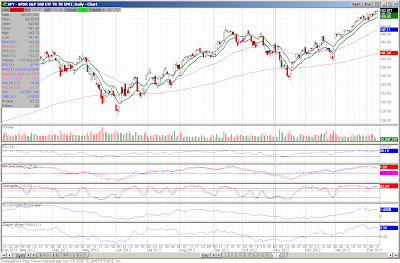A note on price/volume diffusion index before I get into any updates, you may notice there are changes to the price/volume diffusion index beginning this week comparatively to prior weeks.Although the methodology remains unchanged, I altered the weighting scheme of the component measures. Additionally, the time frame used to calculate a few of the component measures within the index were also shortened in order to receive more timely signals. I will reference the updated model in all future commentary on the price/volume diffusion index.
The price/volume diffusion index remains positively biased, sitting at 61.7 through the close Monday. This is above the 50 level indicating higher price and higher volume levels, and improved from the 56.8 in the week ago period. That said, the diffusion index is down from levels seen in late December last year and early January this year, indicating that demand may be trailing off as prices increase.
Price/Volume Diffusion Index vs. S&P 500

To me, this reflects the step down in upside volume levels in the latest weeks, seen below in the trading of the S&P 500 Spider (ticker SPY).
Additionally, the largest volume increase since November have come in on the downside, suggesting weakening supply and demand dynamics. Despite this dynamic, the market has been pulled higher, as euphoria swept investors following the 'resolution' to fiscal cliff talks in D.C. We shall see if the positive bias continues however, as volume levels in the most recent week has fallen precipitously with equity prices trading into the November and December 2007 downdrafts. This suggests that demand is waning heading into supply lines.
Additionally, the slope of the raw indicator measure remains weak relative to results seen late last year, another negative indicator.

That all said, the market is still likely to go higher from here. Not only is the diffusion index still positive, indicating positive future performance on the market, provided history as a guide, but also the rolling summation indicator remains in an up trend.

For me to turn negative on the market, I would need the price/volume diffusion index to turn down in conjunction with the summation indicator that is rolling over or flattening out. This has not occurred yet, and I would remain positively biased, albeit with reservations.
The price/volume diffusion index remains positively biased, sitting at 61.7 through the close Monday. This is above the 50 level indicating higher price and higher volume levels, and improved from the 56.8 in the week ago period. That said, the diffusion index is down from levels seen in late December last year and early January this year, indicating that demand may be trailing off as prices increase.
Price/Volume Diffusion Index vs. S&P 500
To me, this reflects the step down in upside volume levels in the latest weeks, seen below in the trading of the S&P 500 Spider (ticker SPY).
Additionally, the largest volume increase since November have come in on the downside, suggesting weakening supply and demand dynamics. Despite this dynamic, the market has been pulled higher, as euphoria swept investors following the 'resolution' to fiscal cliff talks in D.C. We shall see if the positive bias continues however, as volume levels in the most recent week has fallen precipitously with equity prices trading into the November and December 2007 downdrafts. This suggests that demand is waning heading into supply lines.
Additionally, the slope of the raw indicator measure remains weak relative to results seen late last year, another negative indicator.
That all said, the market is still likely to go higher from here. Not only is the diffusion index still positive, indicating positive future performance on the market, provided history as a guide, but also the rolling summation indicator remains in an up trend.
For me to turn negative on the market, I would need the price/volume diffusion index to turn down in conjunction with the summation indicator that is rolling over or flattening out. This has not occurred yet, and I would remain positively biased, albeit with reservations.

No comments:
Post a Comment